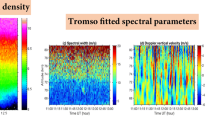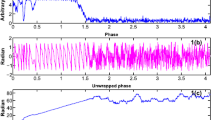Abstract
The durations of radio echo signals scattered from meteor ionized trails might not show a consistent increase corresponding to higher density trails due to the rapid removal of meteor ions at certain heights. Several studies have concluded the dominant role of the secondary ozone layer over diffusion in the removal of the meteor trails below 95 km through chemical oxidization of the meteor ions. Using a basic setup configuration of a forward scattering receiver, a trial to observe the mesospheric ozone concentration was performed by analyzing the meteor echo duration distributions. The forward scattered meteor echoes have the advantage of long durations that can enable observing the transition from the diffusion-removal regime to the chemistry-removal regime. The cumulative meteor echo duration distribution of two meteor showers, the Perseids and the Geminids, were analyzed over 10 years and the chemistry-removal regime in each shower was observed. The knee duration position at which a drop in the number of long overdense meteor echoes starts differed by around 30 seconds between the two showers. As the secondary ozone concentration is inversely related to the solar activity level, the Geminids 2011 corresponding to a high solar activity level showed a significant higher counts of long duration echoes compared to the Geminids 2006 during a low activity level, with the knee position shifted to longer duration. The knee positions obtained during the two distinct meteor showers and the two half solar cycle points are generally in agreement with the mesospheric ozone conditions expected in each case. However, continuous data record is required for the other meteor showers and the sporadic meteors at different heights to observe the mesospheric ozone concentration vertically and the full 11-years solar cycle.









Similar content being viewed by others
References
Baggaley, W.J.: The interpretation of overdense radio meteor echo duration characteristics. Bull. Astron. Inst. Czechoslov. 30, 184–189 (1979)
Baggaley, W.J., Cummack, C.H.: Meteor train ion chemistry. J. Atmos. Terr. Phys. 36, 1759 (1974)
Carbognani, A., De Meyere, M., Foschini, L., Steyaert, C.: On the meteor height from forward scatter radio observations. Astron. Astrophys. 361, 293 (2001)
Ceplecha, Z., Borovička, J., Elford, W.G., ReVelle, D.O., Hawkes, R.L., Porubčan, V., Šimek, M.: Meteor phenomena and bodies. Space Sci. Rev. 84(3–4), 327–471 (1998)
Davis, J.A., Greenhow, J.S., Hall, J.E.: The effect of attachment on radio echo observations of meteors. Proc. R. Soc. Lond. Ser. A, Math. Phys. Sci. 253(1272), 130–139 (1959)
Forsyth, P.A., Vogan, E.L.: Forward scattering of radio waves by meteor trails. Can. J. Phys. 33(5), 176–188 (1955)
International Meteor Organization: Some classical radio meteor astronomy set-ups, http://www.imo.net/radio/practical/setups. Fig. 8. Accessed March 2016
Jacchia, L.G., Verniani, F., Briggs, R.E.: Selected results from precision-reduced super-Schmidt meteors. Smithson. Contrib. Astrophys. 11, 1 (1967)
Jones, J., McIntosh, B.A., Simek, M.: Ozone and the duration of overdense radio meteors. J. Atmos. Terr. Phys. 52(4), 253–258 (1990)
Kaiser, T.R.: Radio echo studies of meteor ionization. Adv. Phys. 2(8), 495–544 (1953)
Madkour, W., Yamamoto, M.-Y., Kakinami, Y., Mizumoto, S.: A low cost meteor observation system using radio forward scattering and the interferometry technique. Exp. Astron. 41, 243–257 (2016)
McKinley, D.W.R.: Meteor Science and Engineering. McGraw-Hill, New York (1961)
Merkel, A.W., Harder, J.W., Marsh, D.R., Smith, A.K., Fontenla, J.M., Woods, T.N.: The impact of solar spectral irradiance variability on middle atmospheric ozone. Geophys. Res. Lett. 38, L13802 (2011)
Neslusan, L.: A summary of the research of Geminid meteoroid stream. Contrib. Astron. Obs. Skaln. Pleso 45, 60–82 (2015)
Noguchi, K., Yamamoto, M.-Y.: Development of an automatic echo-counting program for HROFFT spectrogram. Earth Moon Planets 102, 323–329 (2008)
Smith, A.K., Harvey, V.L., Mlynczak, M.G., Funke, B., García-Comas, M., Hervig, M., et al.: Satellite observations of ozone in the upper mesosphere. J. Geophys. Res., Atmos. 118, 1–19 (2013)
Author information
Authors and Affiliations
Corresponding author
Rights and permissions
About this article
Cite this article
Madkour, W., Yamamoto, My. Mesospheric observations by a forward scattering meteor radar basic setup. Astrophys Space Sci 361, 247 (2016). https://doi.org/10.1007/s10509-016-2832-y
Received:
Accepted:
Published:
DOI: https://doi.org/10.1007/s10509-016-2832-y




